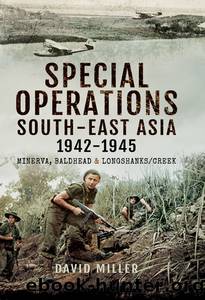Special Operations South-East Asia 1942â1945 by David Miller

Author:David Miller [Miller, David]
Language: eng
Format: epub
Tags: History, Military, Special Forces, World War II, Asia, General
ISBN: 9781473874220
Google: JWHNDwAAQBAJ
Publisher: Casemate Publishers
Published: 2015-11-30T02:56:34+00:00
Table 2. Allied Merchant Ships Sunk in Areas Relevant to India86
These sinkings caused increasing alarm in various Allied headquarters and major efforts were made to find a cause. One possibility seemed to be that Axis submarines were being informed of Allied shipping movements and a rumour soon gained ground that information on sailings from Bombay was being taken by courier to Goa, where it was handed to Robert Koch, a German resident, who then took it to Ehrenfels, which had a powerful transmitter which was transmitting nightly to submarines at sea.
Conclusions
There was no question of the presence or nationalities of the four ships in Mormugao Harbour being hidden in any way; they lay at anchor several hundred yards offshore in full public view, flew their national ensigns daily and members of their crews regularly went ashore. Up to February 1942 it was entirely reasonable that the British should have suspected that one or more of the ships might break out and attempt to reach France, where they would be refitted as AMCs. But, once the Japanese had captured Singapore, the Dutch East Indies and the Andaman Islands, there was no longer a need for them to sail around Africa and up through the Atlantic, as they could now sail to a Japanese-occupied port.
Furthermore, once German U-boats were known to be operating in the Indian Ocean, it seemed possible that one or more of them might enter Mormugao Harbour after dark, and either refuel from one of the German ships, land sick crewmen or deliver equipment, as was known to have happened in Spanish ports.
It was, therefore, entirely reasonable for British Intelligence to have viewed these four ships with grave suspicion. Among other measures, an âAide Memoireâ was presented to the Portuguese government by the British ambassador in Lisbon on 13 March 1942. This stated that the four Axis ships in Mormugao â⦠may receive instructions to attempt to break out of their place of refuge and take an active part in the war, for instance as supply ships to navy vesselsâ.87
Download
This site does not store any files on its server. We only index and link to content provided by other sites. Please contact the content providers to delete copyright contents if any and email us, we'll remove relevant links or contents immediately.
The Radium Girls by Kate Moore(11644)
100 Deadly Skills by Clint Emerson(4705)
The Templars by Dan Jones(4562)
Rise and Kill First by Ronen Bergman(4555)
The Doomsday Machine by Daniel Ellsberg(4255)
The Rape of Nanking by Iris Chang(4029)
Killing England by Bill O'Reilly(3901)
Hitler in Los Angeles by Steven J. Ross(3805)
Stalin by Stephen Kotkin(3732)
12 Strong by Doug Stanton(3424)
Hitler's Monsters by Eric Kurlander(3176)
Blood and Sand by Alex Von Tunzelmann(3067)
Darkest Hour by Anthony McCarten(3019)
The Code Book by Simon Singh(2878)
The Art of War Visualized by Jessica Hagy(2846)
Hitler's Flying Saucers: A Guide to German Flying Discs of the Second World War by Stevens Henry(2631)
Babylon's Ark by Lawrence Anthony(2439)
The Second World Wars by Victor Davis Hanson(2425)
Tobruk by Peter Fitzsimons(2381)
